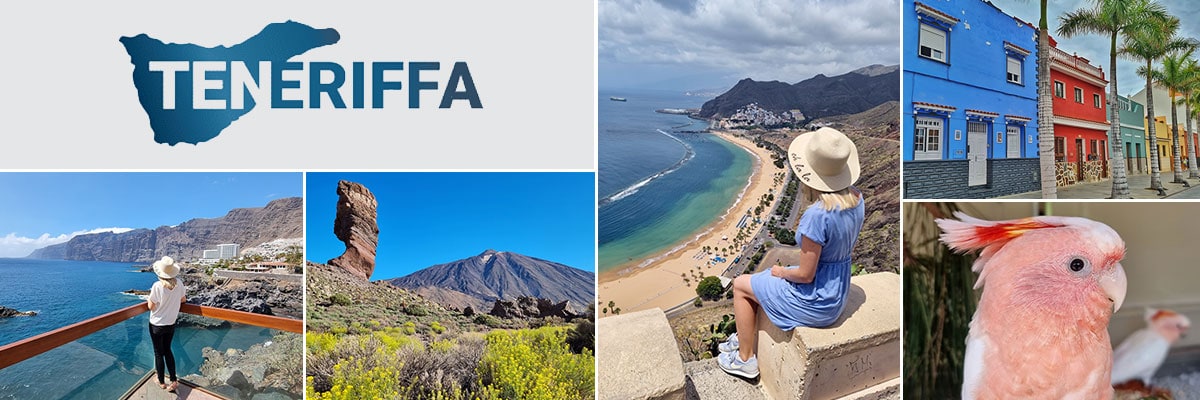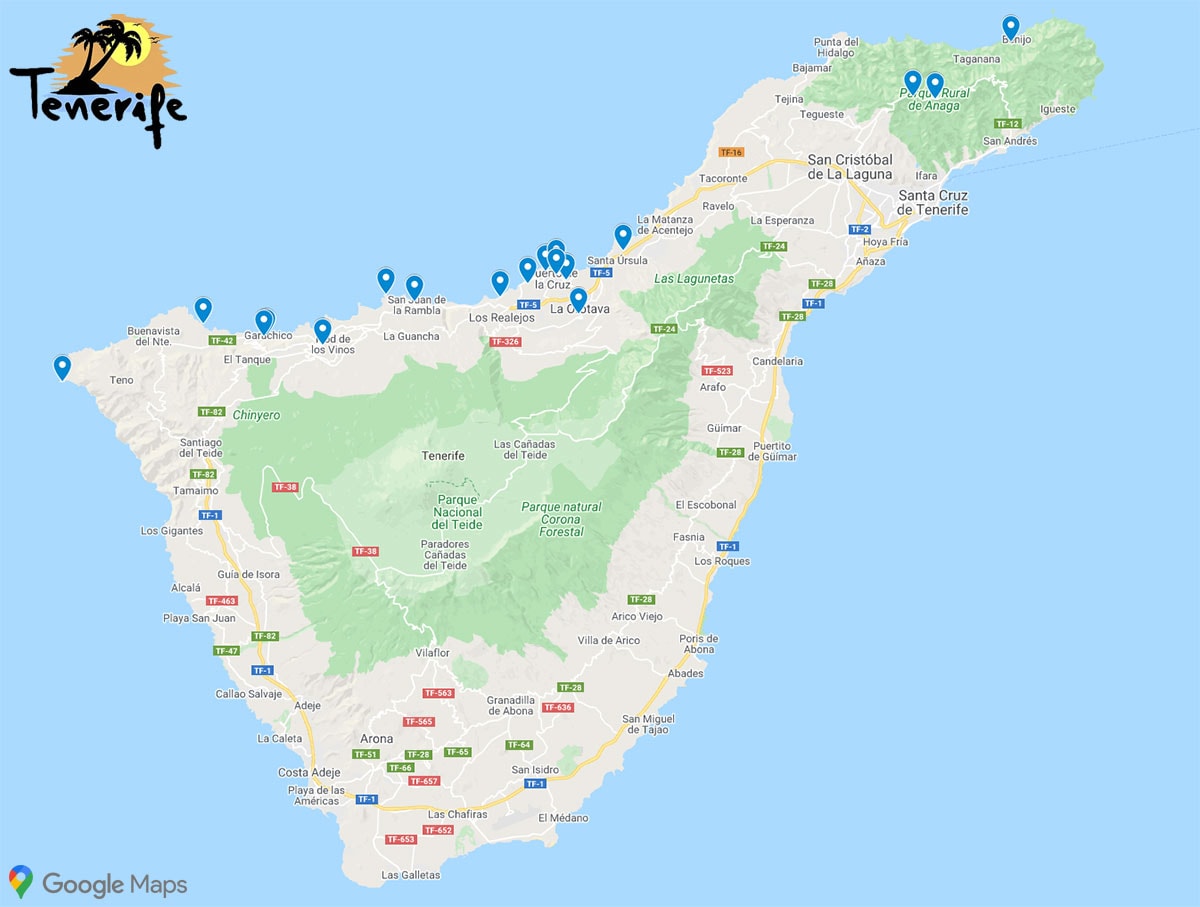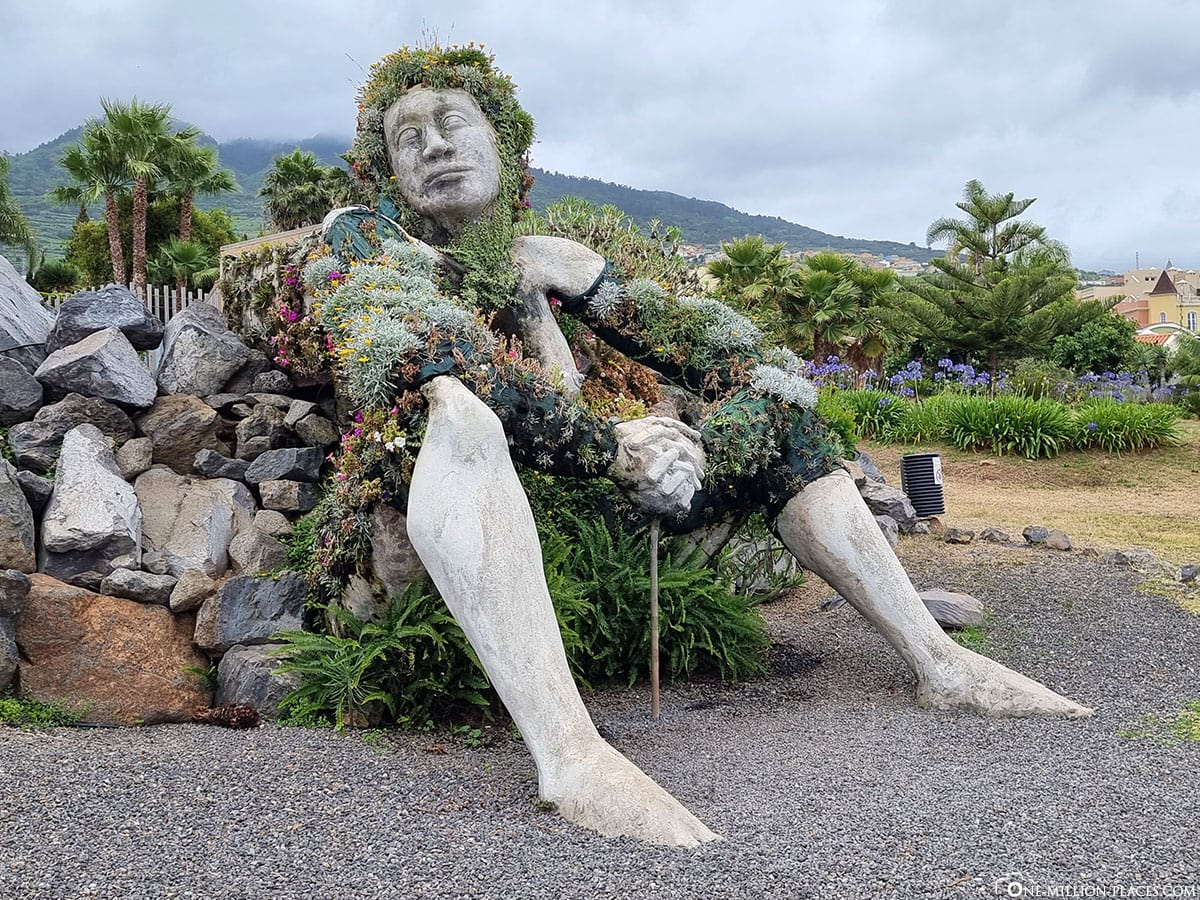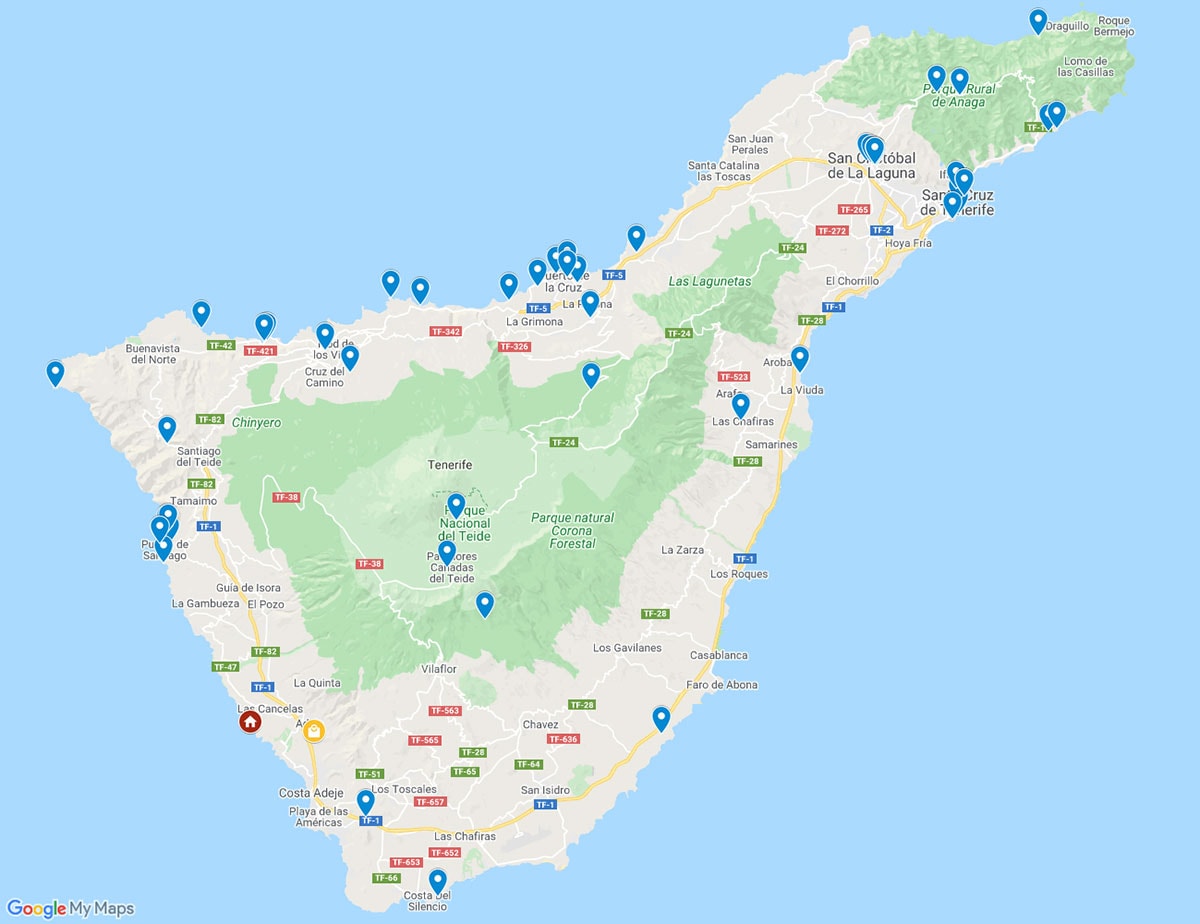The green north coast of Tenerife has some sights to offer, which we have driven with our rental car in several days. Starting from the tourist center Puerto de La Cruz, the world-famous Zoo Loro Park, the imposing industrial ruins Casa Hamilton in the cliffs by the sea, the old town of La Orotava with the “houses of the balconies”, the concrete figure “La Giganta” in the Social La Quinta Garden, the Anaga mountains to many black beaches and beautiful natural pools made of lava rock.
Table of contents
The north coast of Tenerife
The north of Tenerife is often referred to as the green part of the island, while the south presents itself much barren. This is mainly due to the trade wind clouds, which often get caught in the mountain walls on this side of the island and lead to more precipitation. In our week in Tenerife we often experienced that we had the most beautiful weather in our Hotel RIU Buenavista in Playa Paraiso and the north coast was shrouded in thick clouds. But the landscape here is beautifully green and there is a lush vegetation, while the south is often very dry and barren.
On the north coast you will find many small historic towns and numerous natural pools. The “Piscinas Naturales”, as the seawater swimming pools are called in Spanish, were created during various volcanic eruptions and today invite you to protected bathing. The main cities on the north coast are Puerto de La Cruz, La Orotava, Los Silos, Santa Ursula, Garachino, Icod de los Vinos and Buenavista del North.
Sights & the most beautiful photo spots
The lighthouse at Cape Punta de Teno
The Cape Punta de Teno is located about 9 km west of Buenavista del Norte, in the Natural Park of Teno (Parque Rural de Teno). The cape is the westernmost point of the island of Tenerife and you have from here a wonderful view of the steep cliffs of Los Gigantes and in good weather also to the neighboring islands of La Gomera and La Palma. At the end of the peninsula there are 2 lighthouses: the older one dates from 1893, the larger tower directly behind it from 1976. The newer lighthouse in white-red colors (“Faro de Teno”) is 20 meters high and has a fire height of 60 meters.
Since April 2019, the road to Cape Punta de Teno has been closed to private traffic during the day from 10 am to 7 pm (in the summer months from 9 am to 8 pm). At this time, a shuttle bus (line 369) runs every hour from buenavista del Norte bus station. The fare is 1 EUR per person.
The natural pool Charco los Chochos & the whale skeleton in Los Silos
In the small village of Los Silos we made a short detour to the coast. Here is the beautiful natural pool “Charco Los Chochos” as well as a 17-meter-long whale skeleton. The skeleton is a female sei whale that washed up on the coast of Tenerife in 2005. It was placed on two steel beams by the sea and stands as a symbol of marine protection and the preservation of the biodiversity of the oceans.
Both sights are located on the promenade of Playa del Puertito and are freely accessible. If you go a little further along the promenade, you will still come to the viewing point El Bufadero (the end of the fauchen). El Bufadero is a blowhole in which – with appropriate waves – two water fountains are shot out of the lava stone. With us, the blowhole has really blown loudly with every wave, but without splashing water into the air 😉
The town of Garachico & the monument Tensei Tenmoku
The small town of Garachico was once the economic center of the Canary Islands and a prestigious port city. This ended in 1706 with the eruption of the Montańa de Trebejo volcano, whose lava flows buried almost the entire city. Thus Garachico lost the rank as the most important port of Tenerife and was replaced by Puerto de la Cruz.
We took a short tour of the city of Garachico and strolled a little through the small alleys. On the south side of the Plaza de la Libertad rises the three-nave Basilica Iglesia Parroquial Santa Ana from the 16th century. On the waterfront is the Castillo de San Miguel. The building made of black lava stone originally served to protect the flourishing port and now houses a small historical museum. Just below the Castillo are the natural pools “Piscinas Naturales de El Caletón”, which can be visited free of charge via various stairs.
A special Instagram photo spot in Tenerife is the monument Tensei Tenmoku (“Door without a Door”) by the Japanese artist Kan Yasuda. The karrarian marble monument was built in Garachico in 2002 and is located on the square at the old pier.
The dragon tree “Drago Milenario”
In the village of Icod de los Vinos stands the largest and most famous dragon tree of the Canary Islands, the Drago Milenario, which is (incorrectly) often referred to as the 1000-year-old dragon tree. Due to its branching sequence and the distances of the flowering periods, however, its age is estimated today at “only” 400 years. It is 16 meters high and measures a circumference of about six meters. It is very interesting that the Canarian dragon tree belongs to the asparagus family. We wouldn’t have guessed that now 😉 Since 1917, the Drago Milenario has been a national monument and, along with the Teide, one of the most famous landmarks of the island. Around the tree a park was created (Parque del Drago), which you can visit for an entrance fee of 5 EUR per person.
Our tip: A great and free view of the dragon tree is from the opposite, elevated Plaza de San Marcos. There are even free toilets, a beautiful church and small market stalls.
The natural pool Charco del Viento
In Tenerife, there are numerous natural pools with impressive rock formations created by volcanic activity. These natural pools fill with sea water and are – in calm seas – a great way to take a dip in an idyllic setting. Such a natural pool – the “Charco del Viento” – we have found in La Guancha. The way there was actually a bit adventurous, because the road was sometimes very narrow. We were all the more surprised when we suddenly came out at a very well-developed parking lot, from which you could reach the natural pool in a few meters on foot. The sea was very rough, so you could not go swimming or bathing here under any circumstances. However, it was very nice to see how the waves whip at the rock formations.
The natural pool Charco De La Laja Puesta De Sol
This beautiful natural pool can be reached by driving through the village of San Juan de la Rambla, turning into Calle Los Sabandenos, driving to the end and looking for a parking space there. From here, a long stone staircase winds down to the natural pool “Charco De Laja Puesta De Sol”. As a rule, you can go swimming in the pool in calm seas, but we had a bit more violent swell, so it was much too dangerous to go in.
The industrial ruins Casa Hamilton
We found one of the most beautiful “Lost Places” in Tenerife on the coast of the village of Los Realejos: the industrial ruins Casa Hamilton. In 1903, the company Hamilton & Co. took a bold and innovative step for the time on the site of the old Juan de Gordejuela watermill: the construction of a steam engine-powered water pump. At that time, this was the first steam engine to be operated in Tenerife. The water was collected in nearby freshwater springs and transported to a height of almost 200 meters to be distributed on the banana plantations in the Orotava Valley.
Unfortunately, the building was not in operation for long. The construction costs of the plant burdened the company, so that the family leased the plant in 1910 and finally sold it in 1919. It is interesting that the municipality is currently trying to have the ruins declared a UNESCO World Heritage Site in order to preserve them for posterity.
Our tip: We parked our rental car on Calle Romantica and then walked along a small trail that led us to the observation deck, from which you have a beautiful view of Casa Hamilton.
The Loro Parque
One of the most famous and beautiful sights in Tenerife is the Loro Parque in the resort of Puerto de la Cruz. Originally conceived as a paradise for parrots (Spanish: Loro), the history of the park began on an area of 13,000 m² and 25 employees. Today, it has the largest and most diverse reserve for parrot species and subspecies in the world and offers a home to about 4,500 animals in 570 species on an area of 135,000 m². In addition to biodiversity, the Loro Park is also characterized by the quality of its near-natural facilities and respect for the environment. As a result, the park was awarded the Travellers’ Choice Award as the “Best Zoo in the World” in 2017, 2018 and 2019. About our visit to the zoo we have written a separate post, which can be found here.
The city of Puerto de la Cruz
The most famous town and tourist center on the north coast of Tenerife is Puerto de la Cruz. We spent a whole day here and find that the city has a lot to offer visitors: from beautiful photo spots in the traditional fishing district of La Ranilla to the refreshing urban swimming pool Costa Martiánez to the impressive Botanical Garden. About our city tour in Puerto de la Cruz we have written a separate post, which can be found here.
The old town of La Orotava & the Casa de los Balcones
La Orotava is a small town with about 42,000 inhabitants and is located at an altitude of about 390 m above sea level south of Puerto de la Cruz. With its neighboring villages, it forms the largest of the 30 municipal areas of Tenerife, for example, a large part of the Teide National Park (about 78%) in the municipal area of La Orotava. The city was founded in 1504; this makes it one of the oldest villages in the Canary Islands.
During our foray through the very beautiful old town of La Orotava, we were able to discover some photogenic corners: traditional mansions with the typical balconies, small sidewalk cafes, the impressive main parish church Iglesia de la Concepción from the 17th century and a pink-colored town hall.
The highlight of La Orotava is the Casa de los Balcones which can be visited today as a museum for an entrance fee of 5 EUR per person. It belongs to a historic complex consisting of three Canarian mansions. The Casa de Los Balcones was completed in June 1632 and consists of three floors as well as several handmade wooden balconies decorated with flowers. Inside the building you can get an impression of how you lived here in earlier times. In addition, the house is considered an important craft center for Canarian hollow hem embroidery and you can even get an insight into the production of this traditional commodity. Especially beautiful we found the courtyard, which is typically Canarian with the two long rows of balconies on the upper floors and the lush planting.
Our tip: Opposite the Casa de los Balcones you can park for free.
The Social La Quinta Garden in Santa Ursula
From the highway TF-5 we made a short detour to the village of Santa Ursula. However, not to take a look at the city, but to take a look at the Social La Quinta Garden. Since 2012, there has been a grey concrete figure called “La Giganta” (Spanish: the giantess), which is overgrown with flowers. Basically, we always think it’s a good idea to equip a park or a city with extraordinary photo spots, but we find this concrete figure and its posture a bit strange.
The north coast in the Anaga Mountains
The approximately 20 km long and 5-10 km wide Anaga mountain massif is located in the northeast of Tenerife and was formed about 7 to 9 million years ago by volcanic activity. With a height of 1,024 meters, the highest point is the Cruz de Taborno in the west of the mountains. In 1987, the Parque Rural de Anaga Natural Park was founded in this mountain massif, which was placed under special protection in 1994. Since 2015, the area has also been declared a biosphere reserve by UNESCO.
Originally we wanted to go to the village of Benijo to see playa de Benijo and the rock formations off the coast. But unfortunately there were construction work on the cliffs on the route, so that the passage was blocked. On the way back we discovered the beautiful photo spot Roque de Las Bodegas, also a rock formation that can be explored via a beautiful path.
A map with all sights & photo spots on Tenerife
On the following map at Google MyMaps we have marked all important sights, attractions and photo spots on Tenerife.Our travel reports from Tenerife
 » Santa Cruz de Tenerife – 8 Things to do & Top Photo Spots
» Santa Cruz de Tenerife – 8 Things to do & Top Photo Spots» The east coast of Tenerife – Attractions & Photo Spots
» The old town of La Laguna & the Rural de Anaga Park
» The Loro Park (Zoo) in Puerto de La Cruz
» The Los Gigantes Cliffs & Mountain village of Masca
» Puerto de la Cruz – Sights & the best Photo Spots
» North coast of Tenerife – Sights, Photo Spots & Things to do
» The Volcano Teide & Parque Nacional del Teide




